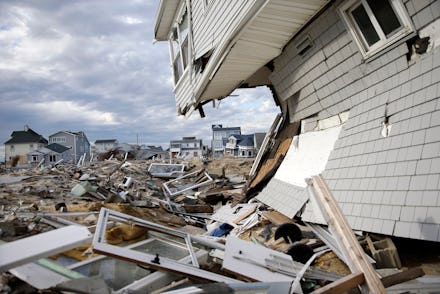Science Says New York City Could Have a Sandy-Sized Hurricane Every 25 Years

Science has some bad news for New Yorkers who are still managing the devastating effects of Hurricane Sandy three years ago.
A study published Monday in the Proceedings of the National Academy of Sciences has found events like Sandy are considerably more likely to hit the Big Apple than previously thought. Rather than once every 500 years or so, the study concluded, a Sandy-like event is more likely to strike the city roughly every 25 years.
"Flood risk has greatly increased for the region" in the anthropogenic era, or 1970 to 2005, the study's authors wrote in its abstract. Researchers compared flood and storm risks between that period and the pre-anthropogenic era, or 850 to 1800. They didn't mince words in their analysis, noting the cause of the increased risk was far from random: "Our results indicate the impacts of climate change on coastal inundation, and call for advanced risk management strategies."
In email to Mic, lead researcher Andra Reed, a doctoral candidate at Pennsylvania State University, put the matter in a starkly human perspective. "A flood of the magnitude that a person may never have seen in a lifetime ... is becoming an event that a person may now see several times during their lifetime in the present climate," she said.
The news was only the latest in a parade of scientific findings in recent years showing the increasingly real effects of manmade global climate change. Another study by Columbia University professor James Hansen concluded sea levels around the world could rise by as much as 10 feet within 50 years, thanks to rapidly melting polar ice caps. Climate change has also been linked to increasingly nasty hurricanes in recent decades, which portends a future with higher storm surges. That's bad news for low-altitude cities like New Orleans.
In the long run, too, flooding in New York may be only among the least of the world's problems. Rising seas have already led to low sea level nations like Bangladesh being inundated with crop-killing salt water. Sea level increases mean the water won't recede after the storm is over. As a result, millions of Bangladeshis face homelessness, the New York Times reported. The disaster of climate change is most acute for Earth's island nations, a number of which now face the real risk of literally vanishing beneath the seas.
"This study certainly highlights the importance of taking steps to mitigate and reduce human-caused climate change," Reed told Mic, adding it was already probably impossible to reverse the effects found in her study. Instead, she said, the world should be focused on solutions to mitigate the rising tide.
"We should also be taking the reality of increased flooding risk into account when rebuilding and recovering from an event such as Sandy," she said, calling for "whatever measures are necessary to have an infrastructure that will be better able to withstand higher flood heights in the future."
With a major climate summit in Paris set for November, this and other studies will likely be on the world's mind.